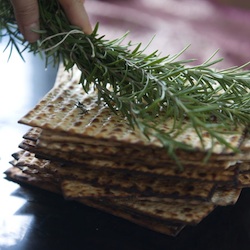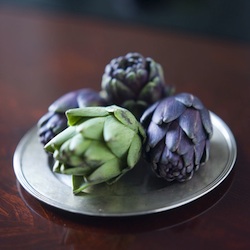Special Feature: Products Sally Recommends
Passover: Your Turn to Host the Seder
 Hosting a seder can be a cook’s nightmare: all those courses, the dietary restrictions--not to mention competing with some guest’s memory of beloved Grandma Becky’s matzoh balls. Relax—with good planning and some streamlining, you can serve a seder that would make any grandmother kvell.
Hosting a seder can be a cook’s nightmare: all those courses, the dietary restrictions--not to mention competing with some guest’s memory of beloved Grandma Becky’s matzoh balls. Relax—with good planning and some streamlining, you can serve a seder that would make any grandmother kvell.
Tradition can have a wonderful taste. But remember that Passover celebrates freedom from slavery, so there’s no reason to remain slaves to the same-old. Even plain matzoh can have a makeover. See the recipe below to transform it easily into a delicious flatbread.
Think green. This was originally a tribal agricultural holiday, celebrating spring. So even if your ancestors spent the holiday in frosty Belarus, emphasize seasonal flavors: vegetables and fruits, like asparagus, artichokes, spinach, leeks, rhubarb; fresh herbs and local ingredients, such as ramps and wild garlic shoots. Include a green salad or cooked vegetable salads as a welcome antidote to a matzoh-rich meal.
The best Passover main courses don't require last-minute preparation and will remain moist and flavorful even if the pre-dinner service runs long. That’s why brisket is so popular and chicken thighs--not breast meat--are another great choice.
While slow-cooked, make-ahead dishes entice with an intoxicating aroma, they often lack zing by the time you eat them. You’re left with a flat taste because none of the exciting top notes remain after the long cooking. The solution? Stir in something fresh at the end to give a burst of flavor—perhaps a few tablespoons of something you initially added in the beginning. That’s how chefs layer with herbs and spices. If you added ginger when you started your dish, include a little freshly grated ginger just before warming it up when serving. I add a garlic and herb gremolata when heating up the gravy for my brisket or chicken thighs with artichokes. A Moroccan-style slow-cooked tagine, like chicken with olives and lemon, is another good option: prepare it ahead, and when reheating, stir in fresh lemon juice and zest, and cilantro or parsley.
Balance rich foods with vegetables served simply. Dress up roasted asparagus with an easy, breadcrumb-like topping of flavorful sautéed matzoh meal or crushed matzoh. Not every dish has to be a kugel or have matzoh: roasted potatoes dusted with fresh thyme or smoked Spanish paprika is an easy crowd-pleaser.
Mini-sized portions make food more exciting to kids. Form tiny meatballs from the same meat mixture you are using for adults. Bake kugels in muffin pans: try potato kugel in mini-muffin tins, lending extra crunch with a crushed potato chip topping.
Or consider a dairy feast. You don’t HAVE to have meat. Make cheese-rich kugels and eggy Sephardi fritadas. Then finish with buttery desserts under drifts of whipped cream. Delicious Passover flour-free mousses, puddings, even rich chocolate cakes are easy when you’re using real butter and cream--and would definitely make for a seder sure to please most children.
Check the dietary customs of your guests. Even Jews who eat non-kosher food throughout the year may observe special restrictions on Passover. And today many families include vegetarians and vegans. Sometimes a simple substitution, like vegetable broth, may be all that's needed to make a recipe meat-free. But vegans—refraining from eggs, plus grains, legumes and derivatives like soy--present a real challenge. Some vegan suggestions: instead of serving an egg course, boil tiny peeled new potatoes to dip in salt water. Steamed spinach and roasted potatoes will never pass for a main course. Instead, layer or stuff vegetables to make them taste more substantial and add some complexity with a textural contrast: zucchini or cabbage filled with potatoes, walnuts, and mint; or matzoh-crusty gratins of pureed cauliflower or squash. Nap sautéed vegetables with a shepherd’s pie blanket of mashed potatoes combined with toasted nuts or garlicky matzoh crumbs. Make burgers of mushrooms, chopped onion, and mashed potatoes. Or prepare dairy-free “pizzas”: fashion a crust of broiled sliced eggplant or a thin layer of well-seasoned mashed potatoes; top with roasted tomatoes and portobellos sprinkled with slivers of garlic and fresh basil. Or try quinoa, the ancient Inca stand-in for grain that is approved by many Orthodox authorities.
Hosting even a simple seder is a lot of work, and you may need some quick fixes. Instead of gefilte fish, serve smoked fish: chopped smoked salmon drizzled with horseradish mayonnaise and nestled in endive or radicchio leaves. Or slow-roast salmon and add beet-horseradish relish for a dish that hits all the familiar flavors without the heavy lifting. Poach halibut or other white fillets ahead and serve with an herbed mayonnaise or salsa verde. Doctor good-quality purchased chicken broth: simmer it with chunks of boneless, skinless chicken breast and precut raw vegetables, then sprinkle with fresh dill.
Many Passover desserts taste even better when prepared a day or more in advance. Or finish with an easy crumble: lightly sweetened fruit baked with a crust based on crumbled store-bought macaroons. Offer fresh fruits: I toss ripe pineapple with fresh mint and a floral honey.
Lastly, don't be afraid to request help. Ask a guest to make a side dish or dessert. Or host a potluck seder, assembling the meal by assigning different dishes to your guests.
RECIPES
All recipes by Jayne Cohen
Seasoned Matzoh
 Wet matzoh lightly on both sides with cold water (a few spritzes from a water spray bottle or just pat it on both sides with wet hands). Sprinkle the top of the matzoh with coarse salt, and if you’d like, freshly ground coarse pepper, maybe chopped fresh rosemary or other herbs. Then bake it on a rack in a hot oven until it’s dry, crisp, and smells toasty -- 3 to 5 minutes. Or steep minced garlic or onion in good extra virgin olive oil for a while, then brush the oil on the matzoh, using sprigs of rosemary or other herbs as a brush. Sprinkle with salt and bake until hot and just beginning to brown, or toast under broiler. Or gently rub the cut side of a garlic clove or onion over the matzoh until the matzoh is slightly damp. (A couple of vertical slashes in the cut side will make the garlic or onion juices flow more easily so the matzoh won’t break apart in the process.) Sprinkle or spritz with a few drops of water, dust with salt, pepper, and herbs, if desired, such as thyme, rosemary or oregano, and bake until dry and crisp.
Wet matzoh lightly on both sides with cold water (a few spritzes from a water spray bottle or just pat it on both sides with wet hands). Sprinkle the top of the matzoh with coarse salt, and if you’d like, freshly ground coarse pepper, maybe chopped fresh rosemary or other herbs. Then bake it on a rack in a hot oven until it’s dry, crisp, and smells toasty -- 3 to 5 minutes. Or steep minced garlic or onion in good extra virgin olive oil for a while, then brush the oil on the matzoh, using sprigs of rosemary or other herbs as a brush. Sprinkle with salt and bake until hot and just beginning to brown, or toast under broiler. Or gently rub the cut side of a garlic clove or onion over the matzoh until the matzoh is slightly damp. (A couple of vertical slashes in the cut side will make the garlic or onion juices flow more easily so the matzoh won’t break apart in the process.) Sprinkle or spritz with a few drops of water, dust with salt, pepper, and herbs, if desired, such as thyme, rosemary or oregano, and bake until dry and crisp.
Plain matzoh contains just flour and water -- no fats, salt, sugars, additives, or preservatives. Use matzohs to custom-design your own creations, using the above method and seasoning them with whatever you would try on flatbreads or crackers, and enjoy them not only on Passover, but throughout the year. One of my favorites is Yehuda brand whole wheat matzohs, which I serve during the year seasoned with toasted sesame and cumin or with za’atar.
Chicken and Artichokes with 36 Cloves of Garlic
 This recipe completes the circle: it’s a riff on my recipe for Brisket with 36 Cloves of Garlic, which in turn is a play on the French Chicken with 40 Cloves of Garlic. All the garlic turns mellow and sweet with the slow-cooking, and is then pureed to lend body to the pan sauce. A gremolata of more garlic and fresh herbs adds zip to the finished dish.
This recipe completes the circle: it’s a riff on my recipe for Brisket with 36 Cloves of Garlic, which in turn is a play on the French Chicken with 40 Cloves of Garlic. All the garlic turns mellow and sweet with the slow-cooking, and is then pureed to lend body to the pan sauce. A gremolata of more garlic and fresh herbs adds zip to the finished dish.
Yield: 6 to 8 servings
about 36 fat unpeeled garlic cloves (1 2/3 to 2 cups) or an equivalent amount of smaller cloves, plus 1 ½ teaspoons minced garlic
3 tablespoons olive oil
Salt and freshly ground black pepper
About 5 pounds skinless, bone-in chicken thighs and/or legs, all visible fat and gristle removed (getting rid of all this fat now means you won’t have to skim it off later from the gravy)
2 tablespoons cider vinegar
2 1/2 cups chicken broth
2 sprigs fresh rosemary, plus 1 teaspoon chopped leaves
2 sprigs fresh thyme
two 9- or 10-ounce packages of frozen artichokes, thawed and patted dry with paper towels (or an equal amount of trimmed fresh artichoke hearts)
1- 2 tablespoons fresh lemon juice, according to taste
1/2 cup chopped fresh mint
additional herb sprigs for garnish (optional)
Preheat the oven to 300 degrees F.
Drop the garlic cloves into a small saucepan of boiling water for 30 seconds. Drain immediately. Peel as soon as the garlic is cool enough to handle. Set aside on paper towels to dry.
Heat a large, wide Dutch oven or similar heavy ovenproof lidded casserole, or a deep, wide sauté pan over medium-high heat. Swirl in the olive oil and heat until shimmering. Salt and pepper the chicken on both sides, then add to the pan (in batches and with additional oil, if necessary), and sauté until golden-brown on both sides. Transfer the chicken to a platter.
Pour off all but about 1 tablespoon of fat remaining in the pan and add the garlic cloves. Cook over medium heat, stirring occasionally, until the garlic edges are lightly tinged with gold. Add the vinegar and deglaze the pan over medium-high heat, scraping up all the browned bits from the bottom with a wooden spoon. Add the broth and rosemary and thyme sprigs, and reduce the heat to low. Return the chicken pieces to the pan, turn them around in the pan liquid, and spoon the garlic cloves over them. Fit a piece of foil over the chicken, then cover the pan tightly with the lid.
Braise the chicken in the oven for 45 minutes to 1 hour, until tender and cooked through, turning the pieces two or three times in the pan sauce as they braise. About 15-20 minutes before the chicken is done, add the artichokes to the pan, turning them to coat with the pan sauce.
Remove the chicken and artichokes to a platter and tent with foil to keep warm. (At this point, if you are preparing ahead, you can cool the chicken and artichokes in the pan liquid and refrigerate, covered, for a few hours or overnight. Bring everything back to room temperature before proceeding.)
Strain the pan sauce, reserving the garlic and discarding the thyme and rosemary sprigs. Puree the cooked garlic with as much of the strained pan sauce as needed in a food processor or a blender. Transfer the pureed garlic mixture and any remaining pan sauce to the pan. Boil the pan sauce over high heat, uncovered, until reduced to the consistency you desire. Add the lemon juice, minced garlic, and chopped rosemary, and cook, stirring, for 5 minutes. Taste and adjust the seasoning or lemon juice as needed. Add the mint and combine well. Return the chicken and artichokes to the pan, spooning the sauce over them, and cook briefly until heated through.
Arrange the chicken and artichokes on a serving platter. Spoon the sauce generously over all and garnish with additional herbs, if desired. Pass any remaining sauce separately.
Toasted Matzoh Crumbs
Yield: about ½ cup of crumbs, enough to top about 2 pounds asparagus
Even vegetable-haters might try asparagus, fresh spinach, or broccoli sprinkled with these tasty toasted matzoh crumbs. The crumbs also add crunch to gratins, vegetable purees, and more. For a very simple main course during Passover, try sole or snapper, glossed with olive oil or lemony mayonnaise, then sprinkled with the crumbs and baked just until the fish flakes.
While matzoh meal works well here, coarse crumbs home-prepared from whole matzohs really make this dish shine. If you can steal the time, it is worthwhile making a large batch to have on hand throughout the holiday. (See Cook’s Note for method.)
To top roasted asparagus, I often use this flavor combination of tarragon and lemon. But feel free to try other herbs and spices as well.
2 tablespoons extra virgin olive oil
1 teaspoon minced garlic
1/2 cup matzoh meal or coarse matzoh crumbs
Salt and freshly ground black pepper
2 tablespoons minced fresh tarragon
1 teaspoon finely grated lemon zest
Heat the oil in a medium skillet over medium heat. Add the garlic and sauté 1 minute. Add the matzoh meal or crumbs made from whole matzoh, season generously with salt and pepper, and cook, stirring, until light golden brown. Remove the skillet from the heat and stir in the tarragon and lemon zest.
Cook’s Note: To prepare homemade matzoh crumbs from whole matzoh, whirl small pieces of matzoh (egg matzoh makes particularly delicious crumbs) in a blender or food processor using the pulse motion until desired texture is achieved. Or place in a resealable plastic bag and use a rolling pin or your hands to crush the matzoh. A medium grind, with a slightly uneven texture is best for crumb coatings.
Note: This information was accurate when it was published. Please be sure to confirm all rates and details directly with the businesses in question before making your plans.



